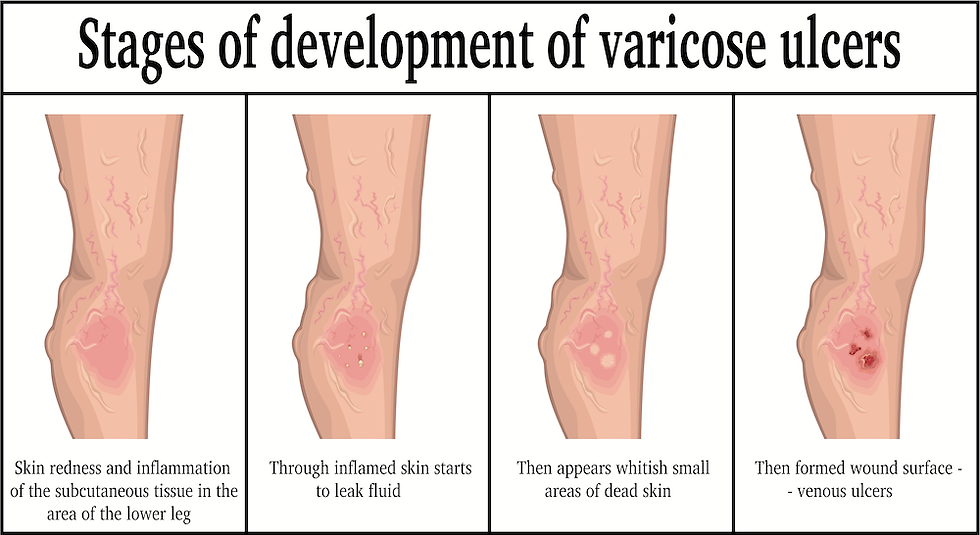Chronic Leg Ulcer
- Fysiobasen

- Sep 9
- 4 min read
A chronic leg ulcer is defined as a wound on the skin below the knee that lasts for more than six weeks and shows no tendency to heal after three months. Chronic leg ulcers are a common problem among adults and cause significant pain and social burden.

Prevalence and Epidemiology
The condition affects about 1% of the adult population, increasing to 3.6% in individuals over 65 years. The disease leads to reduced quality of life, loss of function, and often social isolation. The most common causes of chronic leg ulcers are venous insufficiency (70%), arterial disease (10%), and neuropathy, while mixed ulcers account for approximately 15%. Other, less common causes include metabolic diseases, blood disorders, and infections.
As several factors are often involved, assessment and treatment of chronic leg ulcers always require interdisciplinary collaboration to determine the correct cause, establish an accurate diagnosis, and choose the optimal treatment¹.
Causes and Pathogenesis
Venous ulcers are caused by valve failure in the veins (often varicose veins), leading to blood pooling and increased venous pressure. Ulcers most commonly occur between the ankle and the calf, often on the inner side of the leg (gaiter region). Venous ulcers develop gradually and often follow a long-term, fluctuating course with periods of worsening and improvement.
Arterial ulcers are caused by reduced blood supply due to atherosclerosis, diabetes, or vasculitis. These typically occur on toes, heels, or bony prominences. The ulcer edge is often sharp and well defined, with pale or necrotic tissue at the base.
Diabetic foot ulcers occur in about 15% of all individuals with diabetes during their lifetime.
Pressure ulcers appear over bony prominences, especially the heel, in elderly and immobile patients. Around 70% of pressure ulcers are seen in geriatric patients and may lead to severe infections and complications.
Risk factors: Age, diabetes, stroke, peripheral vascular disease, heart disease, cognitive impairment, poor nutrition, low socioeconomic status, and neurological diseases. Older individuals are at higher risk due to thinner skin, poorer blood supply, and reduced collagen².
Treatment of Chronic Leg Ulcers
Optimal treatment requires an early, systematic, and individualized plan, emphasizing accurate assessment of ulcer type and underlying mechanisms.
Measures include:
Precise wound assessment, clinical examinations, and necessary additional tests
Cleansing and removal of necrotic tissue (debridement)
Antibiotic therapy for infected ulcers
Compression bandaging for venous ulcers to reduce edema and improve blood flow
Ointments and wound creams as needed
Orthopedic aids or splints/braces for gait difficulties
Medications such as pentoxifylline (improves blood flow) and acetylsalicylic acid to prevent blood clots
Surgery may be considered in severe cases
Close follow-up, patient education, and thorough documentation are essential to optimize wound healing¹³.

Physiotherapy
The physiotherapist plays an important role in interdisciplinary wound management, with particular focus on function, strength, movement, and optimal gait. Physical activity also has beneficial effects on mental health and social participation.
Venous leg ulcer: More than 70% of patients have impaired calf muscle pump, which reduces venous return. Training to strengthen the calf muscles (e.g., heel raises, resistance exercises for foot/ankle, walking with good mobility) can improve blood flow and promote wound healing².
Recommended training program: A combination of compression therapy, progressive strength exercises (heel raises, resistance exercises), and at least 30 minutes of walking three times a week improves healing. For every four patients who follow such a program, one more will achieve wound closure compared to compression alone⁴.
Other measures: Gait, transfer, and balance exercises, mobility training, pressure relief, electrophysical modalities, and patient education.
Important Patient Education
Keep the wound clean and dry, wash daily with mild soap and water, and change dressings each day as directed by the physician
Wear appropriate footwear
Exercise while using compression
Elevate legs during rest
Do not use alternative treatments without consulting a physician
Keep a wound diary and monitor carefully
Dressings and Wound Products
Passive dressings (gauze, lint, non-stick): Primarily used as secondary dressings.
Interactive dressings:
Film dressings: Thin, transparent film for light protection
Hydroactive dressings: Highly absorbent, maintain moisture in the wound
Hydrocolloid: Forms a soft gel that promotes natural healing
Hydrofiber/alginate: Form a gel, suitable for exuding wounds
Foam dressings: Soft, well-suited for wounds with moderate to heavy exudate
Alginate: Provides a moist environment and absorbs exudate, especially from bleeding wounds
Compression bandages:Used to secure dressings, support joints, and provide compression in venous insufficiency.
New Treatment Options
Recent research on microRNA and integrin receptors offers hope for new, more effective treatments for chronic wounds. Cell therapy (for example, spray with skin cells) may in the future be used to promote healing¹⁷.
References
Agale SV. Chronic leg ulcers: epidemiology, aetiopathogenesis, and management. Ulcers. 2013 Apr 22;2013. Available from: https://www.hindawi.com/journals/ulcers/2013/413604/ (last accessed: 12.3.2021).
CPA. Leg Ulcers. Available from: https://physiotherapy.ca/impact-chronic-lower-leg-ulcers-within-senior-population-and-role-exercise-fall-2014 (last accessed: 12.3.2021).
Healthline. Leg Ulcers. Available from: https://www.healthline.com/health/leg-ulcers#home-remedies (last accessed: 12.3.2021).
Jull A, Slark J, Parsons J. Prescribed exercise with compression vs compression alone in treating patients with venous leg ulcers: a systematic review and meta-analysis. JAMA Dermatology. 2018;154(11):1304–11. Available from: https://jamanetwork.com/journals/jamadermatology/fullarticle/2705273 (last accessed: 12.3.2021).
Department of Veterans’ Affairs, Australia. Wound care module. Available from: https://www.dva.gov.au/sites/default/files/files/providers/woundcare/dressband.pdf (last accessed: 12.3.2021).
RACGP. Ulcer Management. Available from: https://www.racgp.org.au/afp/2014/september/ulcer-dressings-and-management/ (last accessed: 12.3.2021).
Banerjee J, Sen CK. microRNA and wound healing. In: microRNA: Medical Evidence. Springer, Cham; 2015. p. 291–305. Available from: https://pubmed.ncbi.nlm.nih.gov/26663189/ (last accessed: 13.3.2021).









